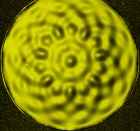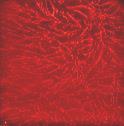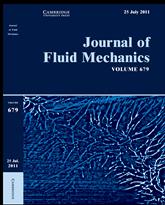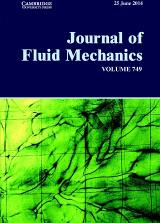
|
A. Turbulent convection Turbulent convection occurs in the large scales of stars & planets, earths atmosphere, oceans, mantles, through the normal scales in manufacturing processes, electronic cooling, day to day cooking to the small scales in biological processes like PCR and in thin films. In spite of its wide presence, significant gaps remain in the understanding of the phenomenology of turbulent convection. Our current research include efforts to understand (a) the nature of buoyancy driven turbulence, (b) the methods of heat transfer from hot surfaces, (c) the structure and dynamics of coherent structures that form on hot surfaces and their role in transporting heat, (d) detection of buoyancy dominated coherent structures (e ) effect of shear on flux and the coherent structures (f) settling of particles in turbulent convection and (g) convection in microscale thin films. Specific ongoing research: 1. Boundary layers, coherent structures and dynamics near hot surfaces in turbulent convection (PhD, Prafulla Shevkar Prakash) 2. Anisotropy and spectra in turbulent convection ( MS, Sanal K. Mohanan) 3. Dynamics of particles near a horizontal hot surface (MS, Prasoon K.K) References : 1. Shevkar, P.P, Gunasegarane, G.S., Mohanan, S.K. and Puthenveettil, B. A., Effect of shear on coherent structures in turbulent convection, Physical Review Fluids, 4, 043502, 2019. 2. Gunasegarane, G. S. and Puthenveettil, B. A., Dynamics of line plumes on horizontal surfaces in turbulent convection, JFM, 749, pp 37-78, 2014 (Cover article for the journal issue). 3. Puthenveettil, B. A., Gunasegarane, G. S., Agrawal, Y. K., Schmeling, D., Bosbach, J. and Arakeri, J. H., Length of near-wall plumes in turbulent convection, JFM, 685, pp335-364, 2011. |

|
Top view of structures on the surface of a horizontal membrane separating a lighter fluid layer below from a heavier fluid layer below |
|
C. Transport across membranes We investigate density driven transport across microporous membranes which occur in many biological systems, filtration, catalysis, carbon sequestration etc. Our investigations have mapped the different regimes of transport for the first time and found out scaling of mass flux in these regimes [1]. New regimes of transport where diffusion balances advection across the membrane has been discovered [2]. A theory for predicting the mean concentration profile on the surface of the membrane was developed and verified. The present research include : 1. Study of strong advective transport across the membrane and the ensuing instability of boundary layers on the membrane (PhD, P. J. Joshy) 2. No similar solutions of natural convection boundary layer equations with transpiration ( MS Neeladr Sekhar Bera) References : 1. Puthenveetil, B.A. and Arakeri, J.H., Convection due to an unstable density difference across a permeable membrane, JFM, vol 609, pp 139-170, 2008. 2. G.V.Ramareddy and Puthenveetil, B.A. The Pe~1 regime of convection across a horizontal permeable membrane, JFM, 679, pp 476-504, 2011, (Cover article for the journal issue). |
|
Research Group |
|
Students : PhD Joshy, P. J., Anoop, P., Anurag Pant, A. M. Ayyappadas, Prafulla Prakash Shevkar, Chitransh Atre MS Sanal Mohanan, Shashank Kumar Gupta, Prasoon K. K., Neeladri Sekhar Bera
Technical staff : Vinod, Technician
Laboratory : Flow Physics Laboratory |
|
Students interested in research in related areas are welcome to contact me by email.
|

|
Surface capillary waves when a fluid layer is vertically vibrated (parametric excitation) |
|
Research Interests |
|
B. Interfacial phenomena Interfaces are nano to micro scale boundaries between phases having an excess of free energy, called the interfacial tension. Interfacial effects are important where interfacial area is large compared to the volume of the fluid, as in multiphase flows, capillary phenomena, phenomena at small scales etc. Interfacial phenomena are some of the most fascinating and the least understood due to the interplay of surface physics with the flow dynamics. Some of our earlier research on interfacial phenomena include, drop ejection from breakup of capillary waves, motion of drops on surfaces, collapse of a bubble at an interface and the subsequent high speed jet ejection etc. Our present research include (a) surface tension driven film spreading at an interface, (b) sedimentation of drops near an inclined surface (c) drag of a surfaces with flexible micro filamets (b) boiling, evaporation, condensation and percolation in porous media. Specific ongoing research : 1. Sedimentation of drops on an inclined surface. (PhD, Anoop, P.) 2. Vortex production and mixing from film spreading of miscible drops on a liquid layer.(PhD, Anurag Pant) 3. Drag of surfaces with micro flexible filaments (M S, Shashank Kumar Gupta) 4. Boiling, evaporation, condensation, percolation in porous media ( PhD, Chitransh Atre)
References: 1. Pant, A. and Puthenveettil, B. A. Vortex ring below a spreading alcohol film on water Journal of Flow Visualization and Image Processing ( in print), 2020. 2. Puthenveettil, B.A., Saha, A., Krishnan, S., Hopfinger, E.J. Shape parameters of a floating bubble, Physics of Fluids 30 (11), 112105, 2018. 3. Dandekar, R, Pant, A. and Puthenveettil, B.A. Film spreading from a miscible drop on a deep liquid layer, JFM, vol 829, pp 304-327, 2017. 4. Krishnan, S, Hopfinger , E. J and Puthenveettil, B.A. On the scaling of jetting from bubble collapse at a liquid surface, JFM, 822, pp 791-812, 2017 5. Puthenveettil,B.A. and Hopfinger, E.J., Evolution and breaking of parametrically forced capillary waves in a circular cylinder, JFM, 633, pp 355-379, 2009. 6. Puthenveettil, B. A. , Senthilkumar,V. K. and Hopfinger, E. J., Motion of drops on inclined surfaces in the inertial regime, JFM, 726, pp 26-61, 2013. (Selected for Focus on Fluids in JFM) |
|
Research Alumni 1. G.V.Ramareddy, (M.S., 2010) PhD student, University of Melbourne. 2. V.Senthil Kumar,(M.S., 2011), Transoft International, Bangalore. 3. G.S. Gunasegarane, (PhD 2015), Associate Professor, Pondicherry Engineering college, Pondicherry. 4. Akhil Varma (MTech ), PhD, LaDyHx, Ecole Polytechnique, Paris 5. Vipin Koothur, (M S 2015), PhD student NTNU, Trondheim, Norway. 6. Raj Dandekar, (BTech student, lab intern), PhD, MIT, USA. 7. Sangeeth, K. ( PhD, 2018), Post Doc, ICTS, TIFR, Bangalore
|


